How to Restore Rusty and Damaged Cast Iron Skillets and Cookware
The best methods for stripping off old seasoning, getting rid of rust, and making old and vintage cast iron skillets, pans, and cookware as good as new.
Serious Eats has become a pretty great resource for cast iron cooking, thanks to some of the articles Kenji has written on the topic, from recipes to care and maintenance guides as well as some serious myth busting.
One of the wonders of cast iron is that it's tough as nails, and can last for generations. For those looking to take their cast iron cooking to the next level, a nice piece of vintage cookware is a pretty sweet first step. It's not that the vintage stuff is worlds better than the modern pans available today—the smoother finish characteristic of very old cast iron provides only marginally better non-stick properties.
But, for those of us nerdy enough to get excited about the details, vintage cast iron has a lot going for it. First, it tends to be lighter than its modern equivalents, which, if you use cast iron regularly, can start to make a difference in your quality of life (at the very least, your back will thank you for it). Second, it has that smooth finish, a final production step from long ago that was eventually dropped in favor of manufacturing speed and efficiency. Aside from the small improvement in non-stick qualities that the smooth surface does offer, it's also just a heck of a lot more beautiful to look at.
But perhaps the best thing about vintage cast iron pans is the past they connect us to—those pans go back to a period of American history dating from the mid-1800s to the early 1900s when cast iron was a serious industry, not just for pans but steam radiators and wood-burning stoves, bridges and even buildings (the Serious Eats headquarters is just blocks from SoHo, home to an amazing collection of 19th century cast-iron architecture).
Beyond the national history, there's the everyday life that's baked into each and every old piece of cast iron cookware: just think of all the meals that have sizzled in a skillet that dates back to the first World War, or the Civil War even.
That's the magic of vintage cast iron, but what about the reality of actually buying it? You could take the easy route and pay a premium for a piece that's already been refurbished. Or you can go the DIY route by picking up a rusted old clunker at a garage sale or flea market and fixing it up yourself. Look online, though, and you'll find a whole lot of different ideas about the best way to clean it up.
Normally here at Serious Eats, we do all of the methodical testing ourselves, but that's not practical with vintage cast iron: I simply can't get my hands on enough to try each and every method out. So for this story I did the next best thing, and got a lesson from Nick Zdon, the product director at Best Made Company, a store dedicated to cool stuff like axes, pocket knives, camp supplies, and other collectibles a guy like me shouldn't be allowed anywhere near lest I bankrupt myself.
Nick started out restoring vintage ax heads, then became interested in cast iron cookware, which he hunts for at junk shops, barn sales, and antique stores in rural Maryland and Pennsylvania.* He's worked on several hundred pieces at this point, and has tried most of the common methods. In short, he's done the legwork so I don't have to.
*If any SE readers in that part of the country have trouble finding vintage pans, you can blame Nick: he says he's pretty much bled those areas dry.
All of the pieces Nick restores are sold at Best Made's Tribeca store and through their website. There's a big batch about to go up at the time of writing, but I can't guarantee they'll still be available when you read this—if past lots are any measure, it's all gonna sell very fast. But that's just fine. "I'd rather teach people how to do it themselves, because this vintage cast iron program we're doing isn't sustainable," he says.
Tips for Buying Vintage Cast Iron
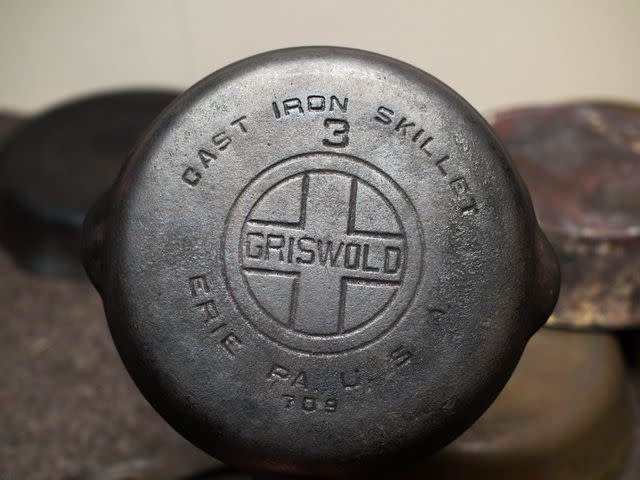
The first step is getting your hands on a piece of vintage cast iron. Books can probably be written on this subject alone, and it can take some time to familiarize yourself with the landscape of the many brand names from America's cast-iron heyday. There are the Griswolds and Wagners, Victors and Favorites, old Lodges, Wapaks, and Birmingham Stove and Ranges. There's more to know than I can hope to cover here, so check out the following sites to get started: The Griswold and Cast Iron Cookware Association, The Cast Iron Collector, and Brimingham Stove and Range.
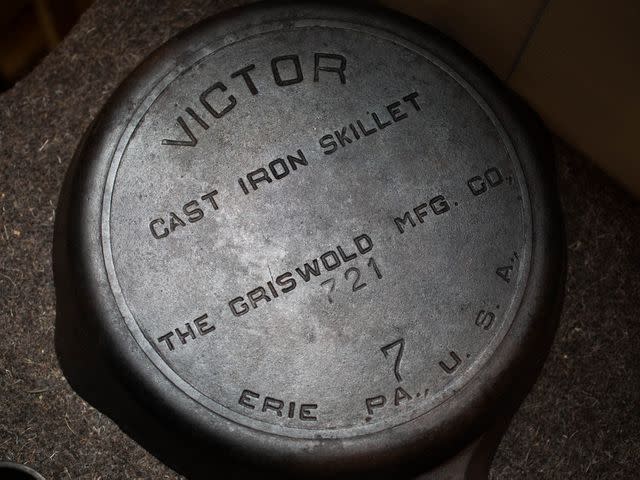
It'll take some time to become familiar with each brand's logo and how it changed over the decades (useful for knowing just how old an antique piece is), but even if you aren't totally up to speed, if you see something that looks old, smooth, and not as heavy as modern pans on sale for cheap, you can always grab it and worry about those details later.
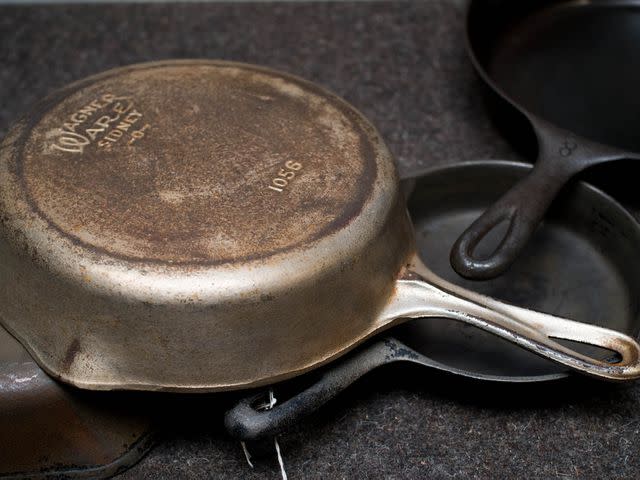
Still, right from the get-go, there are a few things you should definitely look for. First, make sure you're getting plain old cast iron, at least if your goal is a pan that can be seasoned to a non-stick finish. The one you see above, for example, is an old Wagner cast iron skillet that's coated in nickel. There's nothing wrong with it, and it's collectible too, but, like enameled cast iron (e.g. Le Creuset), it can't be seasoned.
Detecting Cracks
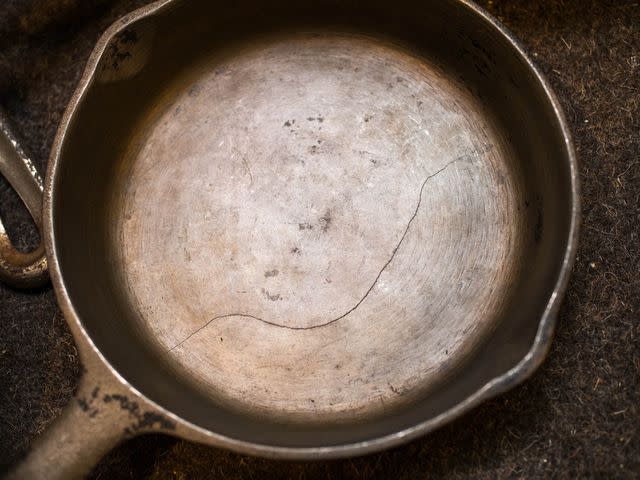
So let's say you're at the junk yard and an old cast iron skillet catches your eye. According to Nick, one of the first steps is to search for cracks, because you don't want a cracked pan—it's a flaw that can render the pan useless. Some cracks, as in the pan above, are easily visible. But others may be buried under layers of rust and seasoning.
The trick, says Nick, is to pick the pan up and rap the bottom of it with your knuckles. A solid, crack-free cast-iron pan will ring with a bell-like resonance. If the sound is dull and clipped, like a cheap piece of tin, move along, since there's likely a crack you can't see.
Pitting and Other Flaws
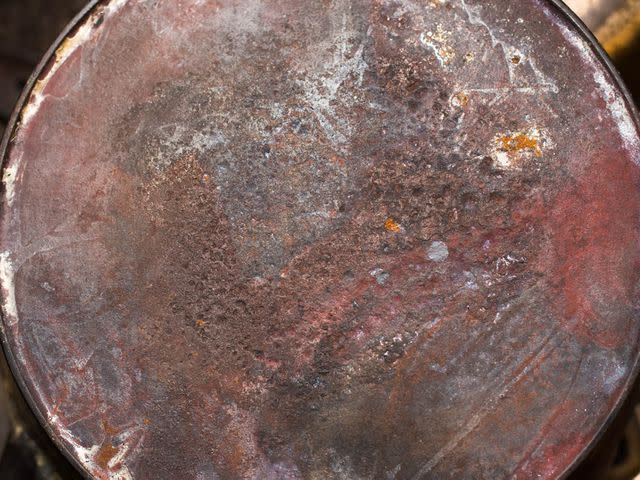
Pitting is another flaw to consider. A lot of old pans will have some pitting, and it's not an absolute deal breaker. Still, it's better to avoid cookware with any more than a tiny amount of pitting on the cooking surface since it can make it more difficult to get a good, even layer of seasoning. Exactly how much pitting you're willing to tolerate, and where it's located, is a personal call.
The reddish color you see on the pan above isn't just rust: it's heat damage to the metal that is irreversible, and it's difficult to build good seasoning on top of it. Some people like to clean their cast iron in an oven set to the cleaning cycle. This can work, but Nick warns against it, since there's a risk that over time it will do exactly this type of damage.
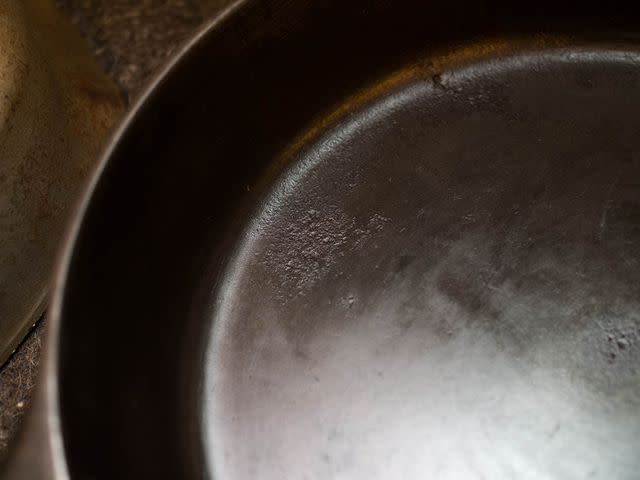
The minor pitting on the cooking surface of the pan above could interfere with an otherwise seasoned finish, though it may be possible to build up enough seasoning to overcome it.
Before buying, it's best to read up on cast-iron defects, including pitting and warping, and whether they're surmountable or not to make an informed decision.
Restoring Cast Iron
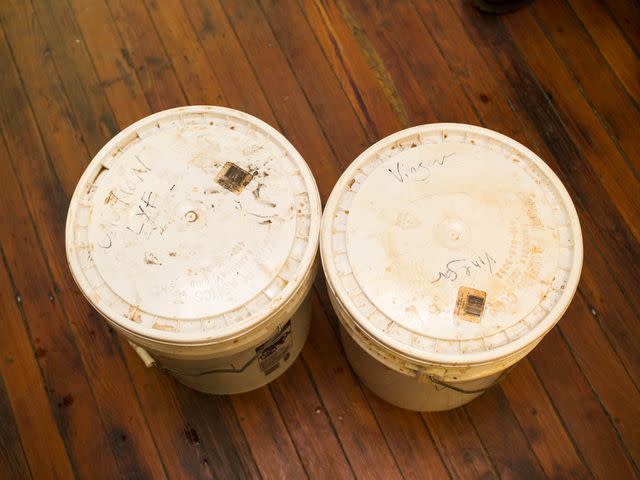
Once you have your cast iron, there are generally two things you'll likely need to do: remove the old layers of seasoning and also get rid of rust. Once a pan is beat up enough, it's not worth trying to salvage the seasoning that's on it. For a really beautiful, functional piece, you're going to want to strip that baby down and then build it back up from scratch.
Not Recommended: Naval Jelly
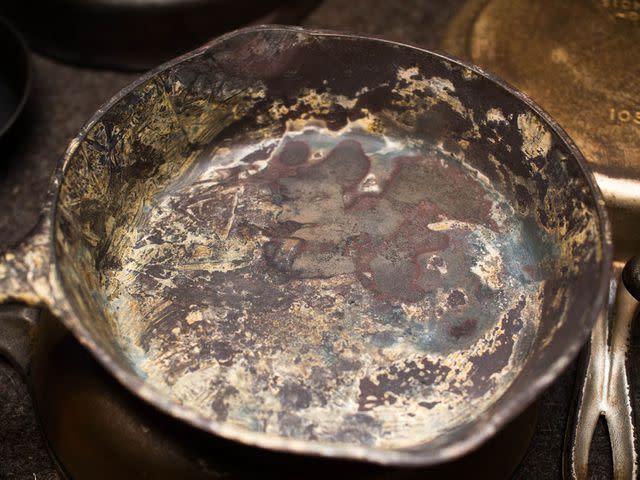
First, a tip on what not to do. Some sites will tell you to use Naval Jelly, a form of phosphoric acid. The photo above is of a pan that had Naval Jelly painted onto it. It dries on, as you can see, and then becomes very difficult to remove. According to Nick, it can work for very small pieces of cast iron that can be fully submerged in the jelly, but most cookware is just too large.
Sandblasting is another method Nick says to steer clear of: it not only cleans everything off, it also permanently alters the original surface of the cast iron.
How to Remove Old Seasoning: Lye
The seasoning on cast iron is polymerized oil, essentially a plastic-like coating that forms when oil is heated in the presence of the iron and oxygen. Lye, the common name of the alkaline compound sodium hydroxide, can break down that polymerized oil.
Lye is used for all sorts of things, from making soap to giving pretzels their deep brown crust, but it needs to be handled with caution: lye solutions are capvable of causing nasty chemical burns and should be treated with the same care as 350°F frying oil. Like hot oil, when handled responsibly, it can be used without trouble—just like frying oil, don't get it on your skin. Make sure to use heavy-duty rubber gloves and eye protection, and keep the rest of your skin covered.
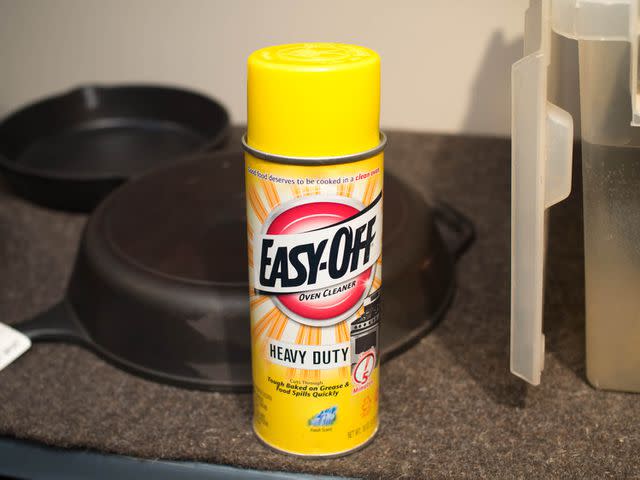
If you have one or two vintage pans, the easiest thing to do, according to Nick, is to use a product like Easy-Off, an oven cleaner that sprays a lye-based foam. To use it, spray the foam all over the cookware, then seal it in heavy duty garbage bags and let it sit for 24 hours.
Then scrub the pans with a heavy duty scrubber to remove the seasoning and strip the pan down to its original metal surface, which you'll recognize by its gunmetal gray color. The downside of Easy-Off is that it will often take several applications and scrubbing sessions before all of the seasoning is removed.
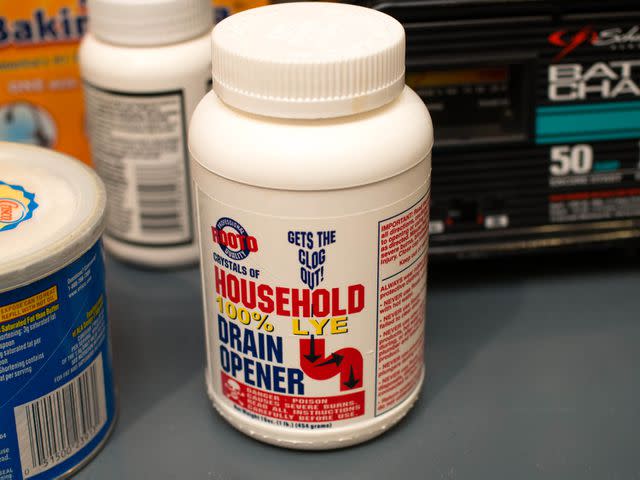
For larger jobs, or if you want speedier results, the next best option is to fill a large plastic bucket with a lye solution and submerge the pans in that. Nick buys lye at hardware stores, such as the bottle of drain cleaner you see above (just make sure the product you buy is pure lye). He adds the one-pound bottle of lye to five gallons of water, and again, take note: you should always add lye to water and not pour water onto the lye, since that can cause a violent reaction.
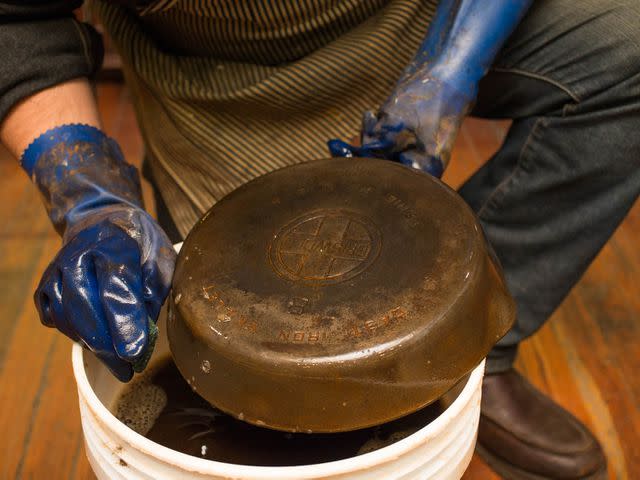
Nick lets the pans soak in the lye solution for 24 hours, then scrubs them. If they need a little more time in the lye solution, he puts them back, checking them and scrubbing from time to time until all the seasoning is removed. The good news is lye won't harm the metal at all, so there's no fear of soaking the cookware for too long in the lye.
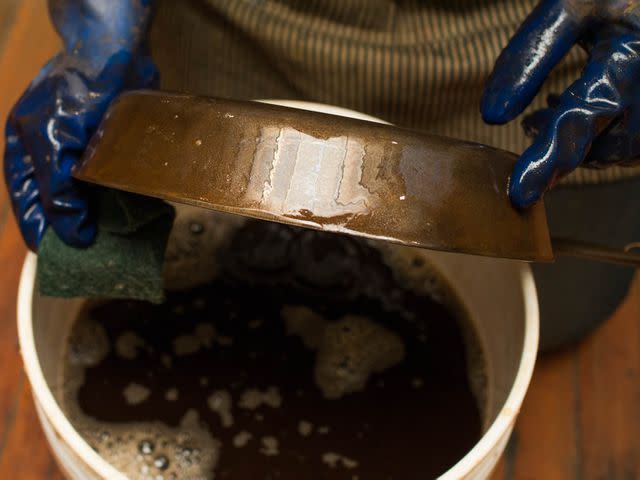
One more safety note: a bucket of lye solution is a dangerous thing, as dangerous as a pot of scalding hot oil. Keep children and pets far away from it, and make sure the lye is not in a place where a curious child or pet could find it on their own; also always keep the bucket securely covered when you're not working on the pans.
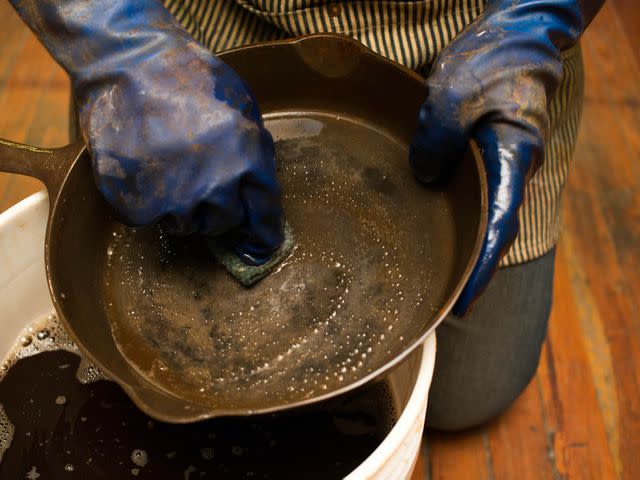
You can see in the photo above that the skillet has just a little more seasoning left (the dark spots) before it's ready to be rinsed and then moved along to the next step.
Removing Rust: Vinegar
Once you've removed all of the old seasoning, the next step is to get rid of any rust. Thankfully, removing rust doesn't require anything as nasty as lye: acetic acid, A.K.A. vinegar, will do the trick. Make sure to buy big jugs of cheap distilled white vinegar for this.
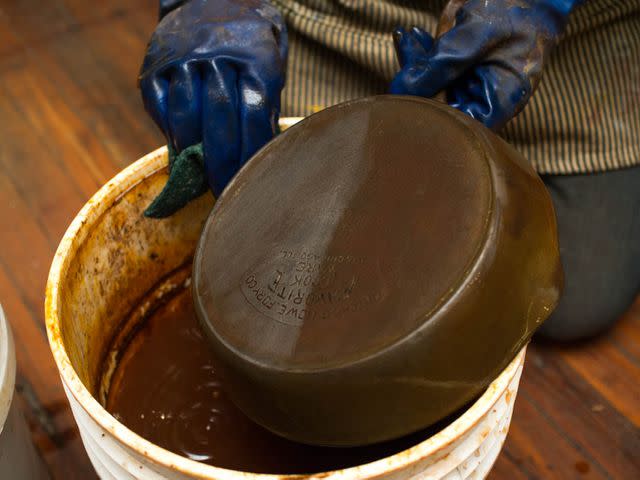
Nick lets his pans soak in the pure distilled white vinegar for six to twelve hours, then scrubs it. But he warns not to ever let this step go longer than 24 hours—vinegar may not present much of a problem to our skin, but it will erode and pit the cast iron if left on for too long.
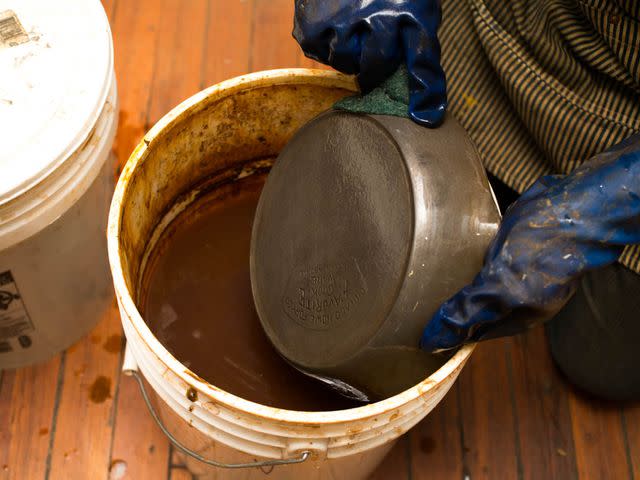
I love these photos: you can finally see the original cast iron emerge.
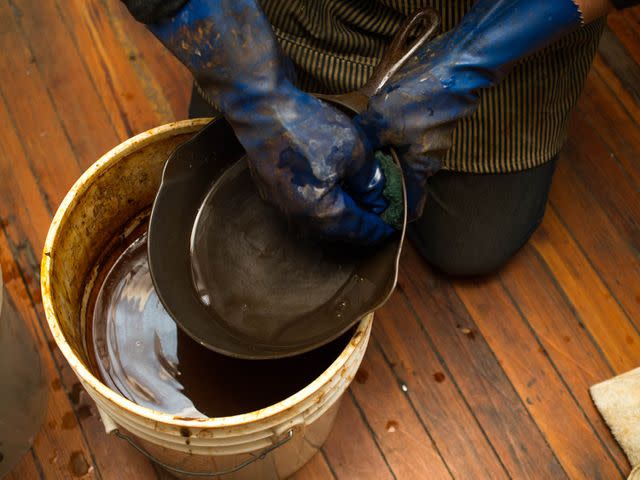
Nick labels each bucket so that there's no confusion about which one contains lye and which one contains vinegar.
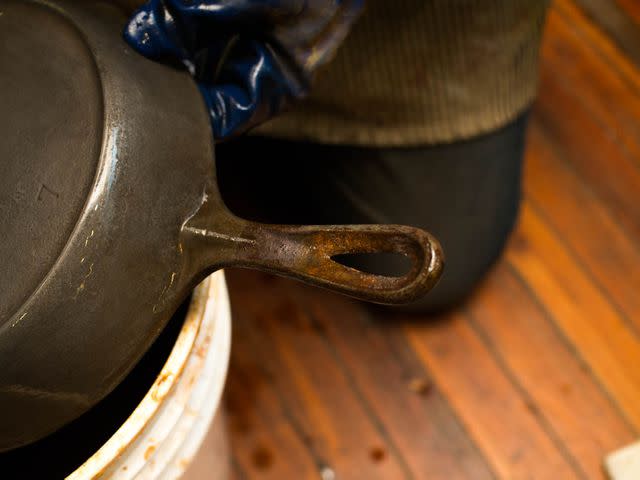
There's just a little rust left on the handle, but otherwise this skillet is ready for its new life. Just note that once exposed, the cast iron will begin to rust almost immediately from the air alone. To prevent that, oil the pan as described below right away.
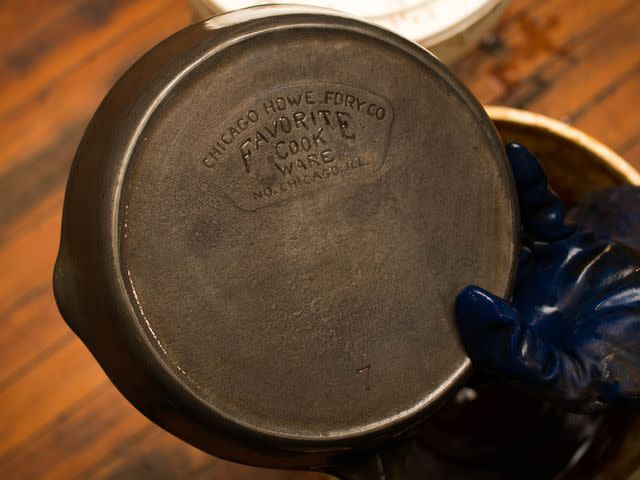
Serious Eats / Daniel Gritzer
A restored vintage piece of cast iron cookware, ready to be seasoned.Removing Seasoning and Rust Simultaneously: Electrolysis
For those who want a solution that deals with the seasoning and rust simultaneously, look no farther than an electrolysis setup. This isn't practical for a lot of people at home, but car enthusiasts may already have the battery charger on hand. If that sounds like you, read on.
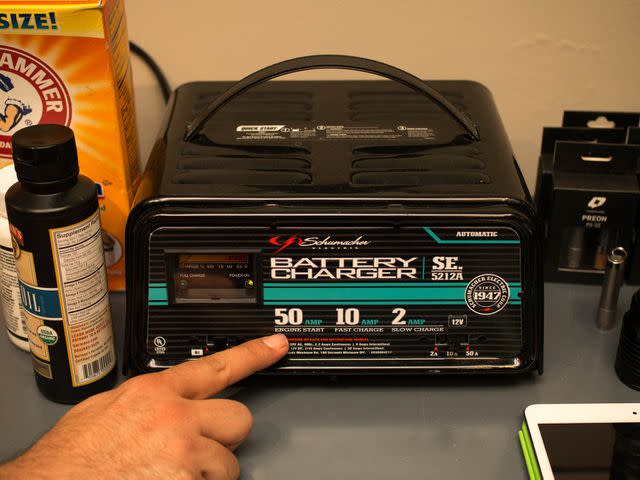
Nick runs his with this Schumacher charger that he sets to 10 amps. He connects the positive red clamp to a steel plate in the tub and the negative black clamp to the pan being cleaned. "Just remember that the black cruddy pan gets the black clamp," he says.
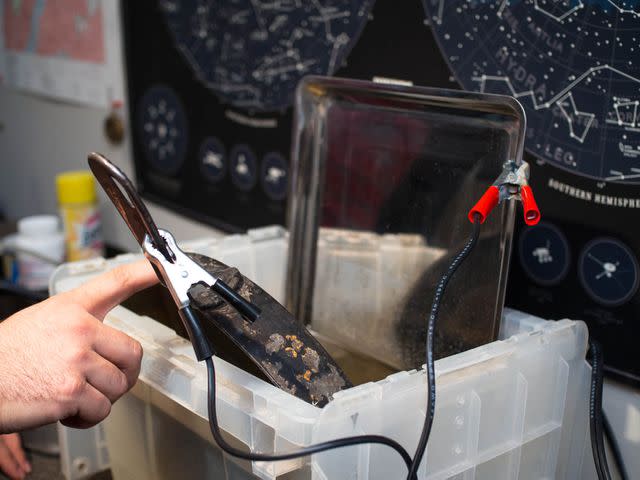
In these photos the pan isn't fully submerged, but it ideally should be, since the only portion of the skillet that gets cleaned is the submerged surface that faces the steel plate. (It also isn't a cast iron pan, but we can ignore that.) Some folks will surround the pan with steel plates on all four sides to speed the process up even more; otherwise you'll need to turn the pan from time to time to expose all surfaces to the current. (Also be sure to turn the battery charger off before touching anything in the setup—there's an electric current running through it, after all.)
The closer the pan is to the steel plates, the better the reaction will be, but they can't touch or it won't work.
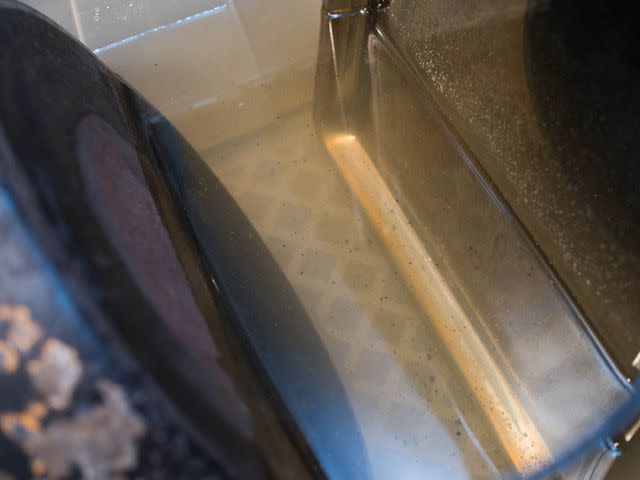
The solution itself is water with about one tablespoon of washing soda (sodium carbonate) mixed in per gallon.
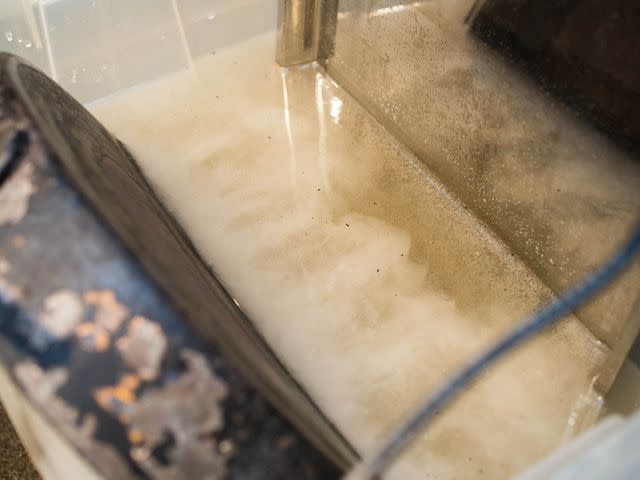
You'll know it's working once it's switched on by the cloudy stream of bubbles flowing between the steel plate and the cast iron.
Nick lets his electrolysis run overnight.
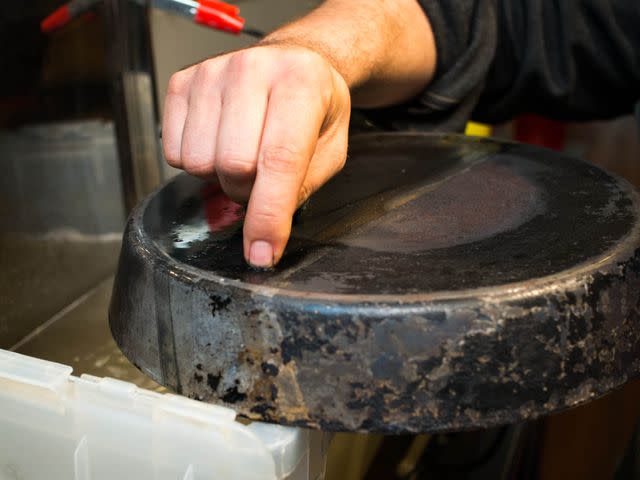
Once it's done, all the crud—both seasoning and rust—should scrape and scrub off.
Post-Stripping Care
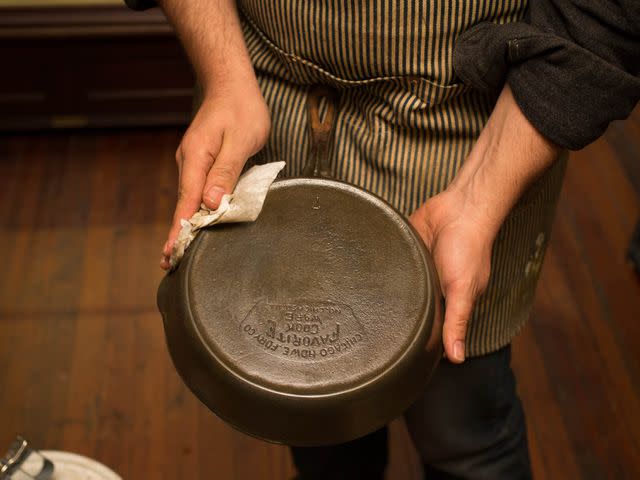
As I mentioned above, cast iron will start to rust almost immediately once it's been stripped down to just the pure metal. If you're not going to season it right away, you can stave off rusting temporarily by rubbing your pan with mineral oil.
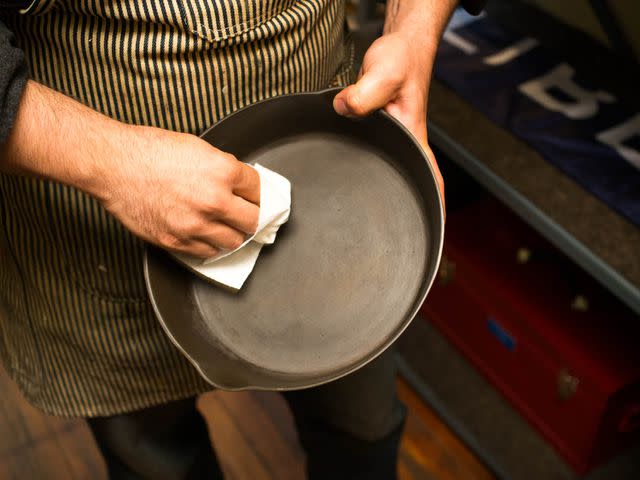
Rub the oil well with a cloth until the shine is gone. Then be sure to wash it off with warm soapy water before attempting to season the pan.
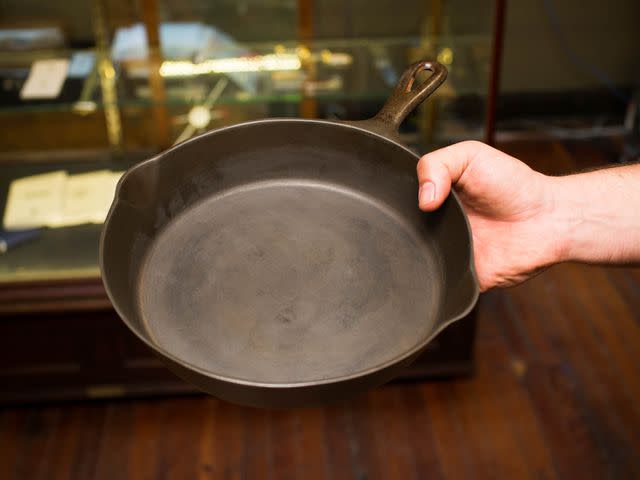
Re-Season
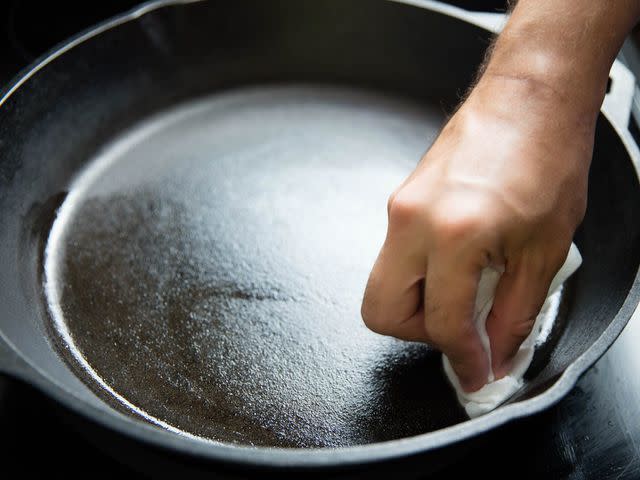
Once you're ready to season, follow our instructions here. Any neutral kitchen oil like corn, vegetable, or canola will work; avoid flax seed oil, which makes beautiful looking seasoning, but has a tendency to wear away easily.
Once you're done, step back and take in the beauty of your work. If you're generous, it'll be a gift for someone you love who also happens to love cast iron cookware. In my case, that'd likely mean I'd give it to myself. 'Cause I'm greedy like that.
December 2014
This article has been updated with improved oil tips for seasoning.

